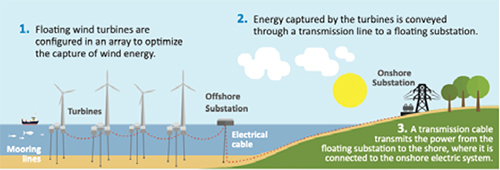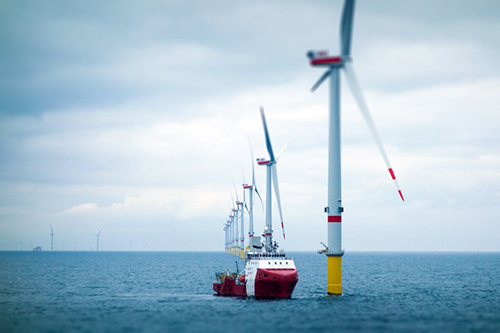This tender ship at an offshore wind farm in Europe is estimated to be over 350-feet long, roughly a little larger than the dredge ship, Yaquina, that annually comes to Morro Bay to dredge the harbor entrance channel. Photo courtesy Castle Wind, LLC
An announcement from the White House seemingly clearing the way for offshore wind farms off the Pacific Coast, appeared to fill the sails on an idea that’s languished for over half a decade, but is offshore wind ready to set sail, or, considering the huge investments needed to make it work, is it mostly a lot of hot air?
The Central Coast and in particular Morro Bay, made nationwide news in May when the Biden Administration announced “a set of bold actions that will catalyze offshore wind energy, strengthen the domestic supply chain, and create good-paying, union jobs.”
The White House said they convened leaders in the Departments of Interior, Commerce and Transportation plus state officials, industry executives and labor leaders to get the ball rolling on offshore wind farms, taking three definitive steps:
- Advance ambitious wind energy projects to create good-paying, union jobs;
- Investing in American infrastructure to strengthen the domestic supply chain and deploy offshore wind energy; and,
- Supporting critical research and development and data-sharing.
Feds Reviewing Proposals
The Bureau of Ocean Energy Management or BOEM, which has been leading the review of offshore wind farms on the West Coast for over 5 years now, announced a new offshore wind area — The New York Bight — off New Jersey and New York’s Long Island in the Western Atlantic Ocean.
This new area, based on an economic study, is supposed to create up to 25,000 “development and construction jobs from 2022 to 2030, as well as an additional 7,000 jobs in communities supported by this development,” according to the release.
That area could also support 4,000 operations and maintenance jobs a year and some 2,000 more jobs in the local communities.
BOEM is supposed to put the N.Y. Bight up for lease sale in late 2021 or early 2022. If that happens it’ll be a great improvement over the time it’s taken to do the same thing on the left coast, which has been mired in red tape and hung up by the Navy’s wish to keep clear its flight training areas in the Pacific.
Nationwide Wind Potential
The Commerce and Interior departments have issued a goal of deploying 30 gigawatts (1,000 megawatts = 1 GW) in offshore wind energy in the U.S. by 2030, “while protecting biodiversity and promoting ocean co-use.”
“Meeting this target,” the release claims, “will trigger more than $12 billion per year in capital investment in projects on both U.S. coasts, create tens of thousands of good-paying, union jobs, with more than 44,000 workers employed in offshore wind by 2030 and nearly 33,000 additional jobs in communities supported by offshore wind activity.

“It will also generate enough power to meet the demand of more than 10 million American homes for a year, and avoid 78 million metric tons of CO2 emissions.”
Towards these ambitious 2030 goals, BOEM is supposed to complete review and lease sales of at least 16 construction plans by 2025, representing more than 19 GW of “clean energy for our nation.”
They’ve taken over 5 years and counting to review the 1,000 MW wind farm that’s been proposed off the Central Coast.
Issues with Supply Chain
Currently, all wind turbine manufacturing is done in East Asia — South Korea and China — but the Biden Administration wants to change that.
“Meeting the 2030 target will catalyze significant supply chain benefits,” the White House said, “including new port upgrade investments totaling more than $500 million; one to two new U.S. factories for each major wind farm component including wind turbine nacelles, blades, towers, foundations, and subsea cables; additional cumulative demand of more than 7 million tons of steel — equivalent to 4-years of output for a typical U.S. steel mill; and the construction of four to six specialized turbine installation vessels in U.S. shipyards, each representing an investment between $250 and $500 million.
The nation’s first tender ship designed to install and maintain these wind turbines is currently being built at a shipyard in Texas using steel produced in Alabama and West Virginia, according to the White House news release.
Big Bucks Available
The Administration also announced a $230 million Department of Transportation grant program — the Port Infrastructure Development Program — to pay for necessary port infrastructure improvements to support offshore wind, which on the Central Coast is a real sticking point, as none of the existing Central Coast ports is capable of handling the needs of this new industry.
The goals are on trend. “In addition to supporting our nation’s long-term economic vitality, DOT’s review process will consider how proposed projects can most effectively address climate change and environmental justice imperatives.”
There is also a lot of money being made available for research and development, some $8 million has already been allocated to 15 East Coast projects.
More millions will be spent studying offshore wind’s impacts to the ocean environment especially fishing.
And the Department of Energy has $3 billion in loans available through the “Title XVII Innovative Energy Loan Guarantee Program.”
Morro Bay Targeted
The Morro Bay Call Area, located about 30 miles off the coast of San Simeon hugging the southwest corner of the Monterey Bay National Marine Sanctuary, and covering some 339 square miles of open ocean, figures prominently in the President’s plans. And our local Congressman is touting the announcement.
“After years of negotiations between federal, state, and local partners,” Rep. Salud Carbajal (D-Santa Barbara) said, “I am thrilled to announce we have an agreement on the size and location of an offshore wind project that serves our environmental, energy, and national security interests.
“Offshore wind holds incredible promise as a means to tackle climate change while also creating economic opportunity, and the Central Coast is uniquely poised to reap the benefits.”
While BOEM and its working group made up of Federal and State officials, hasn’t seemed to have gotten much done, Carbajal formed his own “Offshore Wind Working Group,” with Monterey Congressman Leon Panetta, Jr., BOEM, NOAA the Department of Defense, and Navy, along with the California Energy Commission.
With the review on the Morro Bay Call Area stalled, Carbajal inserted an amendment in the 2021 National Defense Authorization Act, which funds the Defense Department, to get the ball rolling again on the Morro Bay site.
Three Sites Eyed off California
There are actually three sites off California’s Coast — Humboldt Bay (Eureka), the Pecho Coast (off Point Buchon), and the Morro Bay Call Area off the coast of San Simeon. There are also two other sites under consideration that haven’t yet been identified publicly.
That area off San Simeon would first collect the power at a floating substation, then run power through cables on the ocean floor to Morro Rock, where they would run underground through the power plant’s unused outfall canal and connect to the State power grid at a PG&E switchyard on the power plant property.
Each of the three current sites present separate challenges, with Humboldt not having easy access to the power grid of high voltage lines, and Pecho Coast (off Diablo Canyon) being reserved by the Navy for its training grounds.
So with just the local area in play the Administration believes it would support 4 GW of generation in that 399 square mile area.
Castle Wind proposed a 1,000 MW (1 GW) offshore floating wind farm for that area using 10 MW floating turbines (still under development) that would rise about 600 feet above the surface. Water depth in that area is 800-1,000 feet and platforms would be anchored by chains to giant anchors on the seafloor.
But to get to 4 GW, you’d need four times as many turbines as the 100 Castle Wind has proposed. The Biden Administration thinks up to 7 GW of energy could be produced off California.
BOEM is pledging to finally put the Morro Bay Call Area up for lease auction sometime this summer, but that’s a song that’s been sung for several years now.
Rep. Carbajal is committed. “I remain committed to working with the Bureau of Ocean Energy Management and the Department of the Interior to make sure the voices of local fishermen and all Central Coast residents are heard, as this process moves forward,” he said Carbajal.
Infrastructure Needs Are Many
Saying you want offshore wind and making it happen has a whole bunch of interim steps — involving engineering, manufacturing, facilities and logistics — and would seem to hinge on how close they can build a “Wind Port” facility. According to a Cal Poly economic study released in April, it’s the key for this to be beneficial to SLO County.
Entitled, “Economic Impact of Offshore Wind Farm Development on the Central Coast,” the Cal Poly study “analyzes the regional economic benefit to San Luis Obispo County for 3 to 7 GW of offshore wind (OSW) development along California’s Central Coast. The regional economic benefit considered in this report provides a dynamic summary of the green job opportunities, value added, and fiscal returns from the project over time as a result of recurring project spending to meet the needs of an emerging OSW industry in the county.”
The wind farm will need a “Wind Port” that is a deep water port with room for the large work quays and about 50 acres total land area. Needless to say that isn’t practical in Morro Bay or Port San Luis, SLO County’s two developed ports.
There is however, a small manmade port at the Diablo Canyon Nuclear Power Plant that the study said could be rebuilt for the purpose. There’s also space there for the maintenance yard. Beyond that, Pt. Hueneme, a Naval base in Santa Barbara County, is the next likeliest place.
“Given the massive size of OSW turbines, “ the Cal Poly report said, “final assembly must take place in reinforced quays at a port, either at a waterfront manufacturing hub (likely in Asia) or at a specialized wind port that receives floating foundations, towers and turbines from the manufacturing center and assembles them locally.”
The Wind Port is where most of the tens of thousands of union jobs the Biden Administration claims will be created would be realized.
“Developing a specialized wind port provides a foothold for regional economic values to be generated in California by providing assembly, maintenance and repair jobs for turbines that might otherwise be towed into federal waters off California’s Coast from international manufacturing centers,” the Cal Poly report said.
“Making economic benefits from OSW development a reality for San Luis Obispo County,” the report continued, “will require developing a specialized wind port as a hub for OSW jobs and regional supply-chain development. An important next step to attaining the economic benefits detailed in this report is to conduct a feasibility study for developing a specialized wind port in San Luis Obispo.”
Putting in floating towers, over 30 miles offshore might end up being the easy part of this equation to make offshore wind economical and profitable enough for private investment. It’s a future goal that would seem imperative to get done ASAP.
“In-state production of the full range of OSW farm components, including turbines and floating foundations, is not a reality today, but is possible if State and Federal planners send clear signals to OSW developers that investing in OSW manufacturing capacity in California will be rewarded by long-term market development.
“If state planners fail to provide clear market signals on the outlook for OSW in California,” the report added, “it is likely that much of the supply chain will continue to be outsourced to international manufacturing hubs in China and South Korea for turbines and floating foundations, reducing the potential for economic benefits to be realized over time in California.”
Wind Blowing in Right Direction
Commercial wind farms offshore from California sound like a great idea; but the engineering challenges are immense. For example, the technology is still being developed, as there are currently zero “floating” wind turbines anywhere in the world. And the largest turbines available now are 8 MW.
While wind power is extensive in Europe and beginning to be built on the U.S. East Coast, those are all anchored solidly to the seafloor in relatively shallow waters.
The Pacific Ocean gets deep very quickly and so the concept of floating platforms has been proposed here.
Also, California’s Coast is dotted with various protected marine areas, and National Marine Sanctuaries, like the Monterey Bay NMS, which the Morro Bay Call Area actually straddles.
In the protected areas, it’s prohibited to disturb the seafloor, so floating wind turbines is the only way it could happen.
Whether or not 600-foot tall floating towers can be installed and operate safely in the Pacific is an unproven proposition. Winds offshore are pretty constant but as any fisherman or boater can attest, have the potential to blow up a gale with giant wind waves sweeping across the sea, not to mention the occasional “sneaker wave” a massive wall of water coming seemingly from nowhere.
And then factor in fierce storms blowing down from Alaska or hurricanes blowing up from the Equator and the challenge to maintain the turbines is self-evident. Another idea in the study was that in order for wind turbines to work, they have to be online as much as possible.
Wind Port is Critical
Of course this all makes the maintenance aspects even more important, including the need for the maintenance yard to be within easy reach of a tender boat (300+ feet long).
And then there’s the training aspect, as a representative of Castle Wind once told an audience in Morro Bay, they’d love to use the power plant stacks for training (they’re about the right height, too).
In reality the only place in Morro Bay where a Wind Port is remotely possible is on the closed power plant’s 107 acres. However, plant owner Vistra wants to build the world’s largest “Battery Energy Storage System” (BESS), a 600 MW facility housed in three 35-foot tall buildings equipped with thousands of giant lithium-ion batteries. The BESS would take up much of the plant’s available space, if it gets approved.
But that project would appear to be just the ticket for a wind farm, as it would be able to store the wind energy and release it into the power grid to help even out the peaks and valleys of supply and demand.
But even if the acreage existed here, the harbor is only about 12-15 feet deep and a large tender ship would draft much more than that.
Leases to be Auctioned Off
The BOEM has been promising to hold an auction for the Morro Bay Call Area for several years now and while Castle Wind (originally called Trident Wind) started all this by requesting a lease, and the City of Morro Bay has signed agreements with the company to support its application, several companies have since expressed interest and at this point, there’s no guarantee Castle Wind will win the bid.
Still, the company is sticking to its project. “Castle Wind,” Alla Weinstein, CEO of Castle Wind, LLC, said in a statement sent to EBN, “stands alongside our industry partners in applauding the Biden-Harris Administration and [Calif. Gov. Gavin] Newsom Administration for advancing a landmark agreement to support the development of offshore wind projects in the Pacific.
“California is poised to be a world leader in floating offshore wind technology and has a world-class offshore wind resource off its coast. Capturing this abundant renewable energy resource presents a generational opportunity to deliver significant economic benefits and a new source of reliable clean energy to families and businesses across the State.”
“This historic agreement will bolster Castle Wind’s specific mission of providing lasting economic, energy, and environmental benefits for California’s communities by developing a commercial scale floating offshore wind farm off the coast of Morro Bay in Central California. “
The company is off to a head start on its competitors. “Over 5-years ago,” Weinstein said, “Castle Wind began working directly with commercial fishermen and other stakeholders in Morro Bay. Those efforts resulted in a mutual benefits agreement with the commercial fishermen, which supports offshore wind development.
“We are pleased with today’s announcement and look forward to working together with other stakeholders to secure a lease and move forward with the necessary environmental reviews and state and federal permits to build the first floating offshore wind project in California.”
Find the Cal Poly offshore wind economic study here,



